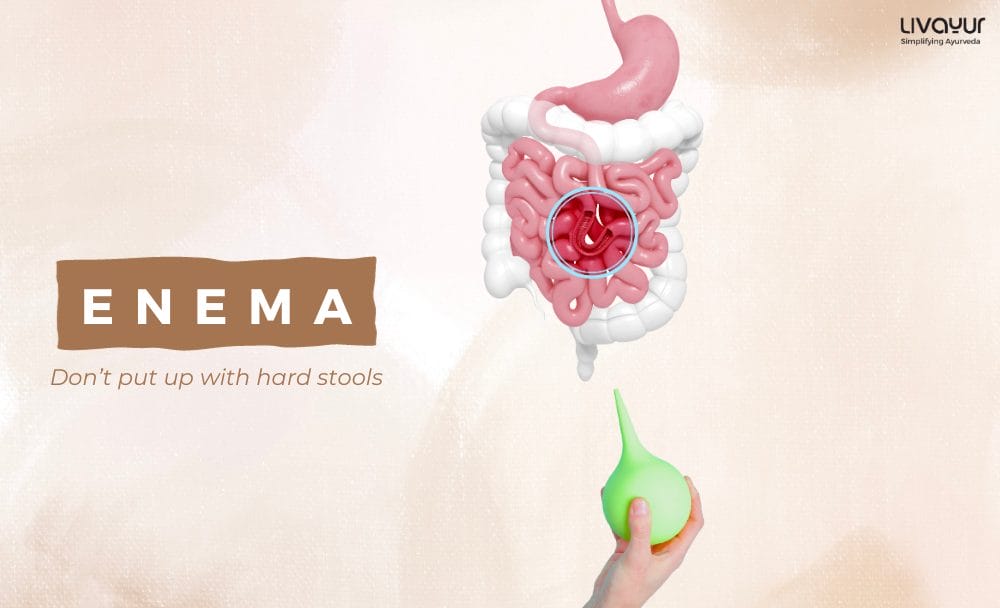
To answer the question what is an enema, we can say that an enema is a medical procedure that involves introducing a liquid into the rectum and colon through the anus with the help of a flexible tube with a hole in the tip. There are usually two main types of enemas, evacuation enemas, which aid in the movement of feces through the bowels, and retention enemas, intended for prolonged retention in the rectum and employed for the administering medications. [1]
Enemas are commonly used to relieve constipation, [2] cleanse the colon before certain medical procedures, and administer medications or fluids. [1] This article aims to offer you a comprehensive overview of enemas, including the enema meaning, its benefits, uses, procedures, and potential side effects.
Benefits of Enemas
Enemas offer several potential benefits for individuals experiencing certain conditions or seeking specific outcomes. Here are some of the key enema benefits:
Enema for constipation relief:
Enemas are commonly used to alleviate acute constipation, especially in the elderly population, by softening the stool and promoting bowel movements. They can provide quick and effective relief when other methods fail. [2]
Colon Cleansing: [3]
Enema can help cleanse the colon by flushing out waste material, toxins, and excess mucus. This process may improve digestion, better nutrient absorption, and overall gut health. [4]
Bowel Preparation:
Before certain medical procedures, such as elective colon and rectal surgical resections or colonoscopy, enemas are employed to empty the colon, ensuring a clearer view for the examination and reducing the risk of complications. [5]
Medication Administration:
Some medications, especially those targeting the lower gastrointestinal tract, can be administered via enema. This method allows for direct delivery to the affected area where it is impossible otherwise and enhances their effectiveness. [6]
The drugs induced this way usually require rapid systemic absorption, such as antiemetics, anesthetics, anticonvulsants, analgesics, and antibacterial agents. [9]
What is enema used for
Enemas find utility in several medical and non-medical contexts. Here are some common enema uses:
Constipation Treatment:

Enema uses are varied and particularly recommended when dietary changes, exercise, and over-the-counter laxatives do not relieve constipation satisfactorily. [2]
Bowel Evacuation:
Enema helps individuals with fecal impaction, a severe form of constipation, to evacuate hardened stool from the rectum and colon. [1]
Colonoscopy/Sigmoidoscopy Preparation:
Before these procedures, a bowel cleansing enema or series of enemas may be prescribed to empty the colon and improve visualization. [7]
Barium Enema:
This diagnostic procedure introduces a contrast agent (barium solution) into the colon. It helps detect the source of bleeding in conditions like diverticular bleeding. [8]
Potential Side Effects of Enemas
While enema is generally safe, they may present certain side effects or risks. These can vary depending on the individual, the specific enema used, and the procedure itself. It is essential to be aware of potential enema side effects, including:
Discomfort:

Some individuals may experience mild to moderate cramping or abdominal discomfort during or after the procedure. This discomfort usually subsides once the enema is expelled. [13]
Electrolyte Imbalance:
Frequent or prolonged use of enema, especially when using sodium phosphate enemas, may disrupt the body’s electrolyte balance. This can lead to dehydration or imbalances in sodium, potassium, or calcium levels. [11]
Perforation or Injury:
Although rare, improper insertion or excessive force during the procedure can potentially cause rectal or colon tissue damage or perforation. This can lead to severe sepsis and, in some cases, even death. [1]
Severe colitis:
Cases of severe colitis with potentially life-threatening consequences have been documented in connection with hydrogen peroxide usage. Apart from this, enemas containing sodium phosphate have been associated with side effects, including hyperphosphatemia, hyponatremia, hypocalcemia, hypokalemia, and metabolic acidosis. [10]
Sepsis or Infection:
Infection is a rare but possible side effect of enema. It can occur if the equipment used is not properly sterilized. [2]
Other side effects:
In some cases, especially glycerine enema, renal failure, accompanied by mild hemolysis and the presence of hemoglobin in the urine, and bleeding from the rectum may occur. There may also be an accumulation of the glycerine enema solution in the retroperitoneal area, resulting in retro peritonitis, swelling, anal bleeding, as well as fever, and vomiting. [12]
FAQs
1. What is the Enema Procedure?
The procedure for administering an enema can vary depending on the specific type and purpose. Here is a general outline of the enema procedure:
Gather Supplies: Gather the necessary supplies, including an enema kit (consisting of a bag, tube, and nozzle), a lubricant (such as petroleum jelly), and a towel or pad to lie on.
Prepare the Solution: Prepare the enema solution as per your healthcare provider’s instructions. Common types include saline solution, mineral oil, or soapsuds.
Positioning: Lie on your left side with your knees bent, or assume the knee-chest position. Alternatively, follow the instructions provided with the enema kit.
Lubrication: Apply a small amount of lubricant to the rectal nozzle to ease insertion.
Insertion: Gently insert the rectal nozzle into the anus, pointing it toward the navel. Insert it approximately 3-4 inches in adults or as per your healthcare provider’s instructions.
Administration: Slowly squeeze the enema bag or bottle to allow the solution to flow into the rectum. Take slow, deep breaths to help relax during the process.
Retention and Disposal: Try to retain the solution for the recommended time (usually a few minutes) before expelling it. Following proper hygiene measures, you can either expel it into a nearby toilet or a designated container.
2. Is enema safe according to Ayurveda?
According to Ayurvedic science, the enema Ayurvedic treatment or Basti Karma is a vital procedure in Panchakarma, frequently administered through the anal route. It possesses multifaceted effects, acting as the primary treatment (Pradhana Chikitsa) for Vatavyadhis and is also referred to as Ardhachikitsa. Enemas are believed to primarily affect the Vata dosha, which governs movement and elimination in the body. There are different types of enemas used in Ayurveda, and the purpose of enema is believed to be to pacify excessive Vata dosha. [14]
3. How long does the enema last?
The duration of an enema can vary depending on the specific type and purpose. Generally, the enema solution is retained in the rectum for a few minutes to allow for its therapeutic effects before it is expelled.
Conclusion
Enemas have long been used for various therapeutic and diagnostic purposes, offering benefits such as constipation relief, colon cleansing, and medication administration. While the procedure is generally safe, it is crucial to follow proper instructions and consult a healthcare professional when necessary. Understanding how does an enema work as well as the potential side effects, including cramping, electrolyte imbalances, and bowel dependence, can help individuals make informed decisions regarding enema usage.
Disclaimer:
This article is written from a health and wellness perspective and is not medical advice. Kindly seek the help of a certified medical practitioner before initiating any treatment.
References:
- How to administer an enema
- Perforation and mortality after cleansing enema for acute constipation are not rare but are preventable
- Colon cleansing regimens. A clinical study in 1200 patients
- Treatment of irritable bowel syndrome with a novel colonic irrigation system: a pilot study
- Bowel Preparation before Elective Surgery
- Physiological and Pharmaceutical Considerations for Rectal Drug Formulations
- General guidelines for your Flexible Sigmoidoscopy:
- Effectiveness of therapeutic standard concentration barium enema for colonic diverticular bleeding: Preliminary results
- A Simple Method for Enema Administration in One-Day-Old Broiler Chicks
- A phosphate enema-associated chemical colitis
- Systematic review: The adverse effects of sodium phosphate enema
- An Analysis of Adverse Effects in Performing Glycerine Enema Based on a Review of Clinical Papers
- Rectal perforations caused by cleansing enemas in chronically constipated patients: Two case reports
- BASTI KARMA OR ENEMA THERAPY -A CRITICAL REVIEW

























